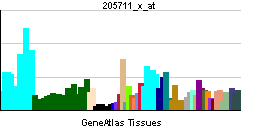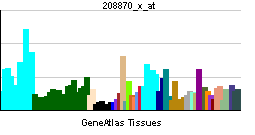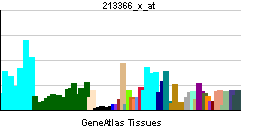ATP5C1
ATP synthase, H+ transporting, mitochondrial F1 complex, gamma polypeptide 1, also known as ATP5C1, is a human gene.[1]
This gene encodes a subunit of mitochondrial ATP synthase. Mitochondrial ATP synthase catalyzes ATP synthesis, utilizing an electrochemical gradient of protons across the inner membrane during oxidative phosphorylation. ATP synthase is composed of two linked multi-subunit complexes: the soluble catalytic core, F1, and the membrane-spanning component, Fo, comprising the proton channel. The catalytic portion of mitochondrial ATP synthase consists of 5 different subunits (alpha, beta, gamma, delta, and epsilon) assembled with a stoichiometry of 3 alpha, 3 beta, and a single representative of the other 3. The proton channel consists of three main subunits (a, b, c). This gene encodes the gamma subunit of the catalytic core. Alternatively spliced transcript variants encoding different isoforms have been identified. This gene also has a pseudogene on chromosome 14.[1]
References
Further reading
- Yoshida M, Muneyuki E, Hisabori T (2001). "ATP synthase--a marvellous rotary engine of the cell". Nat. Rev. Mol. Cell Biol. 2 (9): 669–77. doi:10.1038/35089509. PMID 11533724.
- Abrahams JP, Leslie AG, Lutter R, Walker JE (1994). "Structure at 2.8 A resolution of F1-ATPase from bovine heart mitochondria". Nature. 370 (6491): 621–8. doi:10.1038/370621a0. PMID 8065448.
- Jabs EW, Thomas PJ, Bernstein M; et al. (1994). "Chromosomal localization of genes required for the terminal steps of oxidative metabolism: alpha and gamma subunits of ATP synthase and the phosphate carrier". Hum. Genet. 93 (5): 600–2. PMID 8168843.
- Matsuda C, Endo H, Ohta S, Kagawa Y (1993). "Gene structure of human mitochondrial ATP synthase gamma-subunit. Tissue specificity produced by alternative RNA splicing". J. Biol. Chem. 268 (33): 24950–8. PMID 8227057.
- Elston T, Wang H, Oster G (1998). "Energy transduction in ATP synthase". Nature. 391 (6666): 510–3. doi:10.1038/35185. PMID 9461222.
- Yasuda R, Noji H, Kinosita K, Yoshida M (1998). "F1-ATPase is a highly efficient molecular motor that rotates with discrete 120 degree steps". Cell. 93 (7): 1117–24. PMID 9657145.
- Wang H, Oster G (1998). "Energy transduction in the F1 motor of ATP synthase". Nature. 396 (6708): 279–82. doi:10.1038/24409. PMID 9834036.
- Hayakawa M, Sakashita E, Ueno E; et al. (2002). "Muscle-specific exonic splicing silencer for exon exclusion in human ATP synthase gamma-subunit pre-mRNA". J. Biol. Chem. 277 (9): 6974–84. doi:10.1074/jbc.M110138200. PMID 11744705.
- Strausberg RL, Feingold EA, Grouse LH; et al. (2003). "Generation and initial analysis of more than 15,000 full-length human and mouse cDNA sequences". Proc. Natl. Acad. Sci. U.S.A. 99 (26): 16899–903. doi:10.1073/pnas.242603899. PMID 12477932.
- Cross RL (2004). "Molecular motors: turning the ATP motor". Nature. 427 (6973): 407–8. doi:10.1038/427407b. PMID 14749816.
- Itoh H, Takahashi A, Adachi K; et al. (2004). "Mechanically driven ATP synthesis by F1-ATPase". Nature. 427 (6973): 465–8. doi:10.1038/nature02212. PMID 14749837.
- Deloukas P, Earthrowl ME, Grafham DV; et al. (2004). "The DNA sequence and comparative analysis of human chromosome 10". Nature. 429 (6990): 375–81. doi:10.1038/nature02462. PMID 15164054.
- Gerhard DS, Wagner L, Feingold EA; et al. (2004). "The status, quality, and expansion of the NIH full-length cDNA project: the Mammalian Gene Collection (MGC)". Genome Res. 14 (10B): 2121–7. doi:10.1101/gr.2596504. PMID 15489334.
- Stelzl U, Worm U, Lalowski M; et al. (2005). "A human protein-protein interaction network: a resource for annotating the proteome". Cell. 122 (6): 957–68. doi:10.1016/j.cell.2005.08.029. PMID 16169070.
- Fukumura K, Kato A, Jin Y; et al. (2007). "Tissue-specific splicing regulator Fox-1 induces exon skipping by interfering E complex formation on the downstream intron of human F1gamma gene". Nucleic Acids Res. 35 (16): 5303–11. doi:10.1093/nar/gkm569. PMID 17686786.
| This protein-related article is a stub. You can help Wikipedia by expanding it. |


